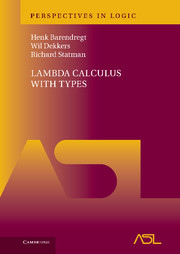Introduction
Published online by Cambridge University Press: 05 August 2013
Summary
The rise of lambda calculus
Lambda calculus is a formalism introduced by Church in 1932 that was intended to be used as a foundation for mathematics, including its computational aspects. Supported by his students Kleene and Rosser – who showed that the prototype system was inconsistent – Church distilled a consistent computational part and ventured in 1936 the Thesis that exactly the intuitively computable functions could be captured by it. He also presented a function that could not be captured by the λ-calculus. In that same year Turing introduced another formalism, describing what are now called Turing Machines, and formulated the related Thesis that exactly the mechanically computable functions are able to be captured by these machines. Turing also showed in the same paper that the question of whether a given statement could be proved(from a given setofaxioms) using the rules of any reasonable system of logic is not computable in this mechanical way. Finally Turing showed that the formalism of λ-calculus and Turing Machines define the same class of functions.
Together Church's Thesis, concerning computability by homo sapiens, and Turing's Thesis, concerning computability by mechanical devices, using formalisms that are equally powerful and that have their computational limitations, made a deep impact on the 20th century philosophy of the power and limitations of the human mind. So far, cognitive neuropsychology has not been able to refute the combined Church-Turing Thesis. On the contrary, that discipline also shows the limitation of human capacities.
Information
- Type
- Chapter
- Information
- Lambda Calculus with Types , pp. xv - xxiiPublisher: Cambridge University PressPrint publication year: 2013
